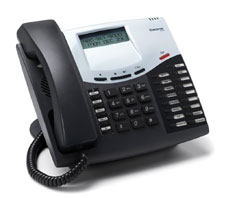IP Telephony
 The
Mitel Axxess and 5000 not only supports IP telephony, but you get
also get the choice of proprietary IP or using of SIP
(Session Initiation Protocol). The
Mitel Axxess and 5000 not only supports IP telephony, but you get
also get the choice of proprietary IP or using of SIP
(Session Initiation Protocol).
IP
In the world of converged voice and data, IP telephony is
already revolutionizing how businesses work. The ability to
run voice and data simultaneously over the same connection
not only brings significant economies to those who have
previously run separate voice and data networks it also
makes the implementation of such facilities as home
worker/remote worker far more cost effective and compelling.
Mitel has been at the forefront of IP telephony since
1997. The Axxess and 5000 platform has evolved and can today offer
the same range of advanced features and facilities to the
user whether they are on a traditional extension or on an IP
extension many hundreds or thousands of miles from the main
telephone system.
Backward compatibility to the existing installed base of Mitel
Axxess platforms will mean that users may migrate
to IP telephony at a rate to suit their application and
budgets.
When an IP handset is in Axxess/5000 IP mode, it
operates like a traditional Mitel handset. The handset
connects via a TCP/IP stream to the Axxess IPRC card or
directly to the 5000. In comparison to SIP mode, IP mode enables all
of the Mitel features and functionality that the system
provides for a traditional handset.
SIP
When Mitel announced the release of Axxess v8.2 &
the 5000 family with it a full suite of IP handsets. The
family of new 8000 handsets includes multi-protocol IP
desktop phones and a Session Initiation Protocol Softphone
for Pocket PC.
Designed to operate on converged IP networks, such as the
internet and corporate LANs/WANs, these new handsets enable
flexible working and remote office applications. The
handsets offer an increased range of features and
functionality, all of which can be configured with either Mitel's Axxess/5000 protocol or SIP.
Due to cost effective pricing, SIP handsets can be used
not only for remote workers, but also as an IP solution for
green field sites. SIP handsets enable the Axxess/5000 to
provide IP to the desktop for customers requiring a
converged platform on a single site.
As a protocol, SIP is designed to provide
interoperability and enhanced services by connecting a wide
variety of multimedia handsets and applications together in
a standard format. With SIP at the core of Mitel's
presence management solutions, business owners and
individual users have more choices, enabling them to
leverage their communications investment by selecting
devices, applications and configurations that best meet
their unique business needs.
Mitel offer an increased range of features and
functionality, all of which can be configured with either Mitelís Axxess/5000 protocol (Axxess/5000 mode) or SIP
(Session Initiation Protocol).
When a handset is in SIP mode, it uses SIP to connect to
the Mitel SIP Server.
One advantage of running in SIP mode is the use of the
Shared Extension Feature. A shared extension allows up to
five SIP handsets to use the same extension number on the
Axxess & 5000 system. This is advantageous because
callers only have to have one number to reach an individual.
When a call comes, all of a users devices ring at once,
allowing the recipient to choose the closest, most
convenient device. Users only have one voicemail box and
only one port is used on the system.
|

